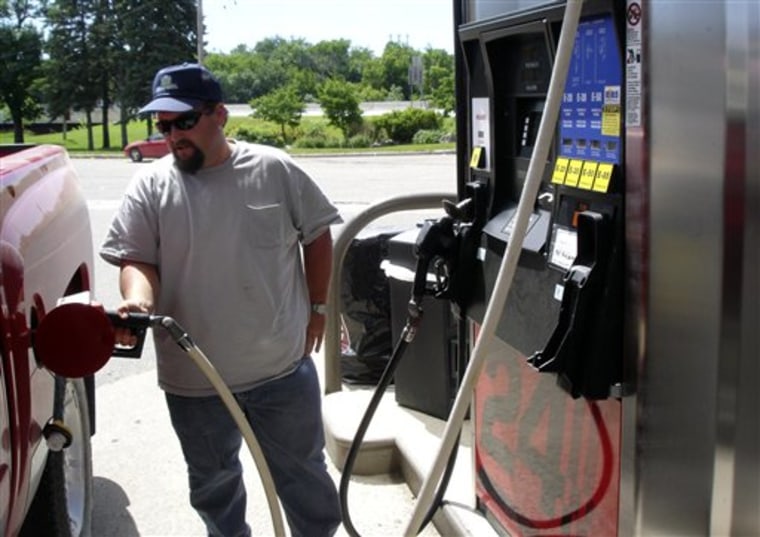To save money and support neighboring farms, Scott Dubbelde began mixing gasoline and cheaper, ethanol-based fuel in his cars years ago, driving first to the gasoline pump, and then to the ethanol pump.
It has worked so well that Dubbelde, who manages a local grain elevator, mixes fuels for all three of his family cars, though only one was designed to handle ethanol-heavy blends.
The practice has caught the attention of the Environmental Protection Agency as a handful of filling stations install pumps that allow drivers to select different ethanol blends with the push of a button.
Auto manufacturers warn that ethanol can corrode fuel lines and damage hoses, seals and the fuel pump in cars not made to carry ethanol. That can lead to bad gas mileage, poor performance and may even affect the vehicle computers that warn of problems.
The EPA says it can damage emission control devices.
Yet with the price for a gallon of gas hitting a string of record highs this year, motorists are paying little heed, even at the risk of voiding their warranties.
"It works good, real good," Dubbelde said of the blends he uses in a Toyota and a Buick, which he improved through a couple years of experimentation. "No 'check engine' light comes on. I don't even think there's a difference in mileage."
The local Cenex gas station installed special blender pumps after managers saw customers mixing their own fuel just like Dubbelde.
Motorists at the station in this western Minnesota town can press a button and fill up with E85, a fuel mixture with up to 85 percent ethanol, or blends varying from 20 percent to 50 percent ethanol. There is little physical difference, except that blending pumps have buttons offering increasing levels of ethanol rather than 87- or 89-octane gas.
Dubbelde pumped E30 into his Buick Rendezvous SUV. He uses E20 in the family's Toyota Avalon and pumps up to 85 percent ethanol into his flexible-fuel pickup truck.
The savings at the pump are real. While regular gas was $3.93 a gallon at Cenex recently, E85 was going for $3.23. E20 was $3.81, E30 was $3.71 and E50 was $3.52 — and that was before the 20-cent-per-gallon discount Cenex offered for ethanol blends 20 percent and up as part of a special promotion that day.
In some Midwestern states, E85 can be as much as a dollar cheaper per gallon than gasoline.
A few dozen gas stations in at least four states — Minnesota, Wisconsin, South Dakota and Kansas — have the new blender pumps. More stations are beginning to ask about them.
Since two Cenex gas stations in Granite Falls and nearby Montevideo installed pumps in late March, overall ethanol sales at the stations have doubled, said Robin Enevoldsen, who manages promotions for the stores.
"At first we were seeing just basic, die-hard ethanol promoters and supporters using them," Enevoldsen said. "Now we see a large percentage of our community using them."
Ethanol advocates acknowledge that there is some misuse of the fuel.
"What an individual does is very difficult to control at the point of sale," said Tim Gerlach, assistant executive director for the Minnesota Corn Growers Association. "I think any retailer will tell you that misfueling is not an uncommon occurrence."
That concerns automakers, who say owners of conventional vehicles are putting their vehicle components and their warranties at risk.
The Alliance of Auto Manufacturers fears new blender pumps will confuse drivers, spokesman Charles Territo said.
"The best way to expand ethanol use is to expand the number of gas stations that offer E85 and not through the use of midlevel blends that could damage conventional vehicles," Territo said.
The EPA said that using blends that contain more than 10 percent ethanol in conventional vehicles could actually increase emissions and therefore violates the Clean Air Act.
"We are aware of this potential misfueling but cannot discuss specific investigations in process," EPA spokeswoman Roxanne Smith said in a written statement. "The EPA is working with industry sectors and states to assure compliance."
Robert White, of the Ethanol Promotion and Information Council, predicts demand for blender pumps will continue to rise. The Omaha, Neb.-based group offers $5,000 grants to encourage more gas stations in South Dakota to bring blender pumps on line. The South Dakota Corn Utilization Council and the ethanol industry are paying for the grants.
"The premise behind it is offering consumers a choice, because they're screaming for it," White said.
Advocates cite studies showing that vehicles can do just as well on 20 percent or 30 percent ethanol as they do with 10 percent.
Gas mileage decreased very little on midlevel ethanol blends compared with gasoline containing 10 percent ethanol — the standard fuel in Minnesota — and the car's components seemed to handle the fuel fine, said Bruce Jones, a researcher at Minnesota State University, Mankato, who has helped lead the studies. Even on flexible-fuel vehicles, gas mileage was often better with a lower grade of ethanol than E85.
Jones, a professor who directs the Minnesota Center for Automotive Research, says more study is needed on ethanol blends, including on emissions. But from what he's seen, he's confident that states like Minnesota will be able to move ahead with plans to eventually mandate 20 percent ethanol in all gasoline sold.
General Motors Corp., Ford Motor Co. and the Chrysler Group have pledged to double production of flexible-fuel vehicles by 2010, and there are also efforts to put flexible-fuel hybrid-electric vehicles on the market.
In rural Minnesota, where daily corn and soybean prices are read over the radio and grain silos far outnumber Toyota Priuses, motorists are not waiting.
"The word is starting to get around," said Rodney Gaffney, a Yellow Medicine County farmer who puts ethanol blends in his flexible-fuel pickup truck and occasionally in his '97 Buick Park Avenue. "We need to keep the money in rural America instead of overseas."
